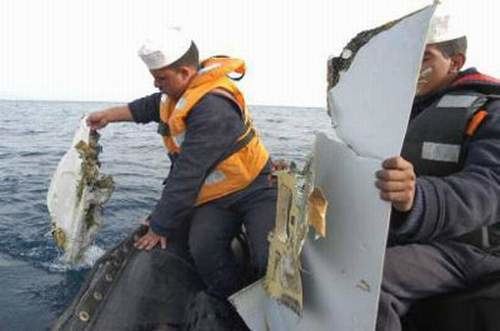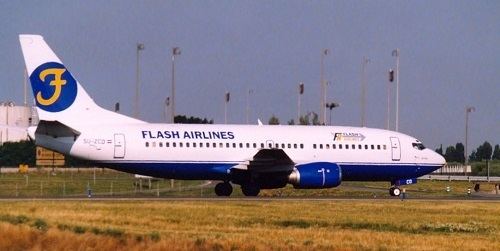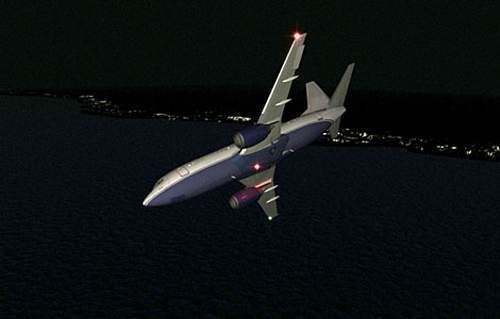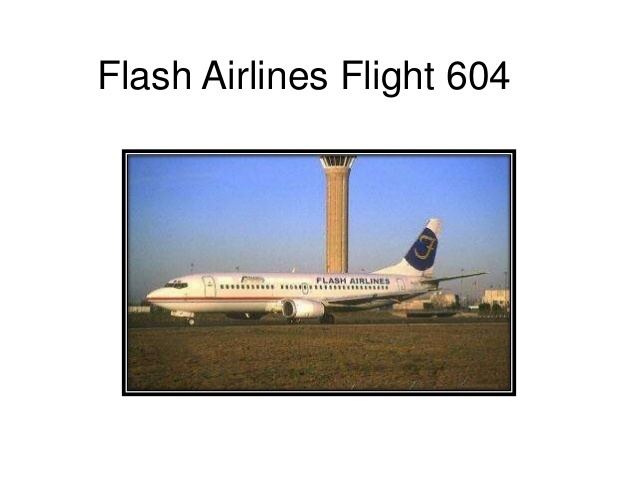Passengers 135 Aircraft type Boeing 737-3Q8 Date 3 January 2004 Total fatalities 148 (all) Passenger count 135 | Survivors 0 Aircraft name Noar Survivor 0 Crew count 13 | |
 | ||
Summary Unresolved (dispute between investigators)Uncommanded bank (possible mechanical or software malfunctions)spatial disorientation, human error and lack of proper adequate crew training. Similar United Airlines Flight 585, Aeroflot Flight 593, Aeroperú Flight 603, Atlantic Southeast Airlines Fl, ValuJet Flight 592 | ||
Fs2004 vertigo flash airlines flight 604
Flash Airlines Flight 604 was a charter flight operated by Egyptian charter company Flash Airlines. On 3 January 2004, the Boeing 737-300 crashed into the Red Sea shortly after takeoff from Sharm El Sheikh International Airport, killing all 135 passengers, most of them French tourists, and all 13 crew members. The findings of the crash investigation are controversial, with accident investigators from the different countries involved not agreeing on the cause.
Contents
- Fs2004 vertigo flash airlines flight 604
- History of the flight
- Passengers and crew
- Investigation
- Dramatization
- References

Flight 604's death toll was the highest of any aviation accident in Egypt until the crash of Metrojet Flight 9268 nearly twelve years later. It remains the deadliest accident involving a Boeing 737-300, and the deadliest involving the Boeing 737 Classic series.

History of the flight

The accident airplane was a Boeing model 737-3Q8 airplane and was equipped two CFM56-3 engines. It was built and delivered to TACA International Airlines as N373TA in October 1992. It had been operated by Flash Airlines since June 2001. At the time of the accident it had accumulated 25603 flight hours and 17976 cycles of takeoffs and landings.
Passengers and crew

Khadr Abdullah (referred to as Mohammed Khedr in a Times Online article) was the captain. He was 53 years of age and was a highly respected pilot with almost 7,500 flight hours under his belt. Amr Al-Shaafei served as the first officer. He was 25 years old with fewer than 800 hours of flying experience. Ashraf Abdelhamid, who also held Canadian and US citizenship, was training as a first officer and had experience flying corporate jets; he sat in the cockpit with the pilot and copilot.

Most of the passengers were French tourists who originated from the Paris metropolitan area. FRAM (FR), a French travel agency, sold most of the tickets to the flight. A provisional passenger list dated 5 January 2004 stated that twelve entire French families had boarded the flight. Members of seventeen families appeared at Charles de Gaulle Airport to take passengers from the flight; this fact gave the airport staff an indication that entire families died on Flight 604.

One of the passengers that was supposed to be on the flight was French citizen Pascal Mercier and his family. He cancelled their reservation because he didn't like the early morning departure time since he had young children and the fact that they would have to stop in Cairo.
Investigation
Initially, it was thought that terrorists might have been involved, as fear of aviation terrorism was high (with several major airlines in previous days cancelling flights on short notice). The British Prime Minister at the time, Tony Blair, was also vacationing in the Sharm El Sheikh area. A group in Yemen said that it destroyed the aircraft as a protest against a new law in France banning headscarves in schools. Accident investigators dismissed terrorism when they discovered that the wreckage was in a tight debris field, indicating that the aircraft crashed in one piece; a bombed aircraft would disintegrate and leave a large debris field.
The wreckage sank to a depth of 1,000 m (3,300 ft), making recovery of the flight data recorder and cockpit voice recorder difficult. However two weeks after the accident, both devices were located by a French salvage vessel and recovered by a ROV. The accident investigators examined the recorders while in Cairo. The maintenance records of the aircraft had not been duplicated; they were destroyed in the crash and no backup copies existed.
The Ministry of Civil Aviation (MCA) investigated the accident, with assistance from the American National Transportation Safety Board (NTSB) and the French Bureau d'Enquêtes et d'Analyses pour la Sécurité de l'Aviation Civile (BEA).
The MCA released its final report into the accident on 25 March 2006. The report did not conclude with a probable cause, listing instead four "possible causes".
The NTSB and the BEA concluded that the pilot suffered Spatial disorientation, and the copilot was unwilling to challenge his more experienced superior. Furthermore, according to the NTSB and BEA, both officers were insufficiently trained. The NTSB stated that the cockpit voice recorder showed that 24 seconds passed after the airliner banked before the pilot began corrective manoeuvres. Egyptian authorities disagreed with this assessment, instead blaming mechanical issues. Shaker Kelada, the lead Egyptian investigator, said that if Hamid, who had more experience than the copilot, detected any problems with the flight, he would have raised objections. Some media reports suggest that the plane crashed due to technical problems, possibly a result of the apparently questionable safety record of the airline. This attitude was shown in a press briefing given by the BEA chief, who was berated by the first officer's mother during a press conference, and demanded that the crew be absolved of fault prior to the completion of the investigation. Two months after the crash Flash Airlines went bankrupt.
US Summary Comments on Draft Final Report of Aircraft Accident Flash Airlines flight 604, Boeing 737-300, SU-ZCF 3 January 2004, Red Sea near Sharm El Sheikh, Egypt. Quote from page 5 of 7:
"Distraction. A few seconds before the captain called for the autopilot to be engaged, the aircraft's pitch began increasing and airspeed began decreasing. These deviations continued during and after the autopilot engagement/disengagement sequence. The captain ultimately allowed the airspeed to decrease to 35 knots below his commanded target airspeed of 220 knots and the climb pitch to reach 22°, which is 10° more than the standard climb pitch of about 12°. During this time, the captain also allowed the aircraft to enter a gradually steepening right bank, which was inconsistent with the flight crew's departure clearance to perform a climbing left turn. These pitch, airspeed and bank angle deviations indicated that the captain directed his attention away from monitoring the attitude indications during and after the autopilot disengagement process. Changes in the autoflight system's mode status offer the best explanation for the captain's distraction. The following changes occurred in the autoflight system's mode status shortly before the initiation of the right roll: (1) manual engagement of the autopilot, (2) automatic transition of roll guidance from heading select to control wheel steering-roll (CWS-R), (3) manual disengagement of the autopilot, and (4) manual reengagement of heading select for roll guidance. The transition to the CWS-R mode occurred in accordance with nominal system operation because the captain was not closely following the flight director guidance at the time of the autopilot engagement. The captain might not have expected the transition, and he might not have understood why it occurred. The captain was probably referring to the mode change from command mode to CWS-R when he stated, “see what the aircraft did?,” shortly after it occurred. The available evidence indicates that the unexpected mode change and the flight crew’s subsequent focus of attention on reestablishing roll guidance for the autoflight system were the most likely reasons for the captain’s distraction from monitoring the attitude".
Problems associated with the complexity of autopilot systems were documented in the June 2008 issue of Aero Safety World. Before the completion of the investigation, Avionics writer David Evans suggested that differences in instrumentation between the MiG-21 (with which the captain had experience) and the Boeing 737 may have contributed to the crash.
Dramatization
Flash Airlines Flight 604 was featured on The documentary television program Mayday episode "Vertigo".
